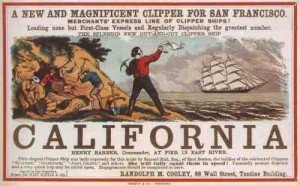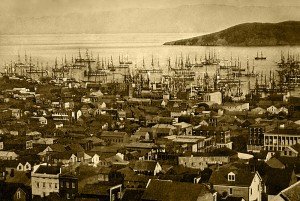While airships to California may sound adventuresome, one of the more interesting museums in New England in the town of Bridgeton Maine is directly connected to this idea. Bridgeton is located about twenty miles west of Interstate 95, about one hundred and forty miles southwest of Bangor and about 143 miles north of Boston, MA. A visit to the Rufus Porter Museum in Bridgeton is truly a Trip Into History and very interesting history indeed. While the name of Rufus Porter may not be a household name to many, Porter was a man of science who we might say thought outside of the box. While not necessarily noted for his scientific calculations and achievements, he was a man with a vision and a man with a will to pursue those visions, at least in writing. That vision was to fly people to the California gold fields in three days. Something I would say unheard of in the late 1840’s.
Thank you for reading this post, don't forget to subscribe!
Rufus Porter was the founder and editor of the weekly Scientific American which printed it’s first issue in 1845. In addition to his literary pursuits, Porter was also an inventor. The early years of the Scientific American reported mostly on inventions and patent office news. It’s been said that Rufus Porter actually had an interest in airships as far back as the 1820’s. In the year 1849 however, he came out with a publication entitled, Aerial Navigation… The Practicability of Traveling Pleasantly and Safely to California in Three Days. Two things were certain. The idea of airship travel to the California Gold Rush was unique to say the least. The second thing was that in the year that Porter released his theory and plan in writing, getting to the California gold fields as fast as possible was on many an easterner’s mind. As a result, Porter’s idea had an instant and at least, early audience. Airships to California was truly a unique theory in 1849.
In the book Anybody’s Gold by author Joseph Henry Jackson, the author describes the difficult ways in which easterners traveled to the California gold fields during the great Gold Rush. Overland travel in 1849 was a bit more than harsh. Between the Indians encountered along the way, mountain passes to cross and the diseases which were rampant over such a long journey, most opted for the steamers. This was a time twenty years before the completion of the transcontinental railroad. Long distance travel options were limited.

Ship travel required one of two routes. Either the long way around Cape Horn and then up the west coasts of South America and then North America or the shorter but not less treacherous route through the Isthmus of Panama and then up the California coast.
Rufus Porter was a dreamer and his dream was to transport the gold seekers by airships over the plains and over the high Rocky Mountains. The proposal in his above mentioned publication was air travel in an era when there was no air travel. Porter’s design was an 800 foot long airship referred to as an “Aerial Locomotive“. The craft’s total weight was estimated at 14,000 pounds. The airship would be held aloft by a bag containing hydrogen gas that would require some 20,000 feet of spruce rods and 8,000 yards of cloth. About 12,000 feet of steel wire would suspend the passenger compartment that was made from wooden boards and painted cloth. Porter estimated that his craft could travel about 100 MPH with the help of steam engines. After all, this was the age of steam power. As far as the threat of a lightening strike, Rufus Porter suggested dragging a small copper wire from the airship that would touch the earth to discharge any electricity. The cost of Porter’s airship design was estimated to be $1,750.
Porter set the price of a ticket to California at $200. If this sounded a bit too high, the maiden trip, or actually trips, would cost a passenger only $50 with carrying no more than three-hundred people at that low price.

The sad but true story regarding the Aerial Locomotive or Porter’s Locomotive is that it never, as a fact, got off the ground even though it was reported that about 200 people did sign up for the first flight. Author Jackson points out that there was never any record that the aircraft was ever actually built. Apparently, a journal at the time, called ” Sherwood’s Pocket Guide to California” , advised anyone of not opting for the air route. It’s also thought that perhaps a real scientist stepped forward and pointed out some of the glaring flaws to Porter’s design. Two problems with the Porter design had to do with air resistance itself which Rufus may not have figured into his equations. Wind direction was another matter altogether. The other problem had to do with pounds of weight per horse-power. In other words, it seems that most if not all of the early enthusiasts had a change of heart and opted for either the cross country route or the sea route of the steamers and sailing ships. To be certain, airships had been experimented with very early on in Europe as well as other places but the grand idea of Rufus Porter was decades ahead of itself. The type of air travel envisioned by Porter would actually occur almost a century later during the era of the mighty German airships such as the Hindenberg dirigible.
The Scientific American that was founded in 1845 by Rufus Porter still publishes to this very day. The first foreign publication went to the presses in 1890. Such world famous scientists as Albert Einstein contributed articles and the magazine is noted as being the oldest continuously published monthly magazine in America.
Rufus Porter passed away in 1884 and even though he actually sold his new magazine not long after it was founded remained an editor at the Scientific American until his death. In addition to his scientific experiments and his revolutionary airship idea, Porter was a well known New England artist. He was a very talented muralist and his works decorated over 150 inns and houses in New England. Some of his works were in monochrome and others in full color.
You will be interested in our related articles Nevada City California and Madame Mustache and the famous gold mining town of Bodie California.
The Rufus Porter Museum and Cultural Heritage Center showcases the contributions of Rufus Porter to American arts, literature, science, and industry. The museum building itself is quite historic, built in 1789 and is located at 67 N. High Street, Bridgton, Maine.
